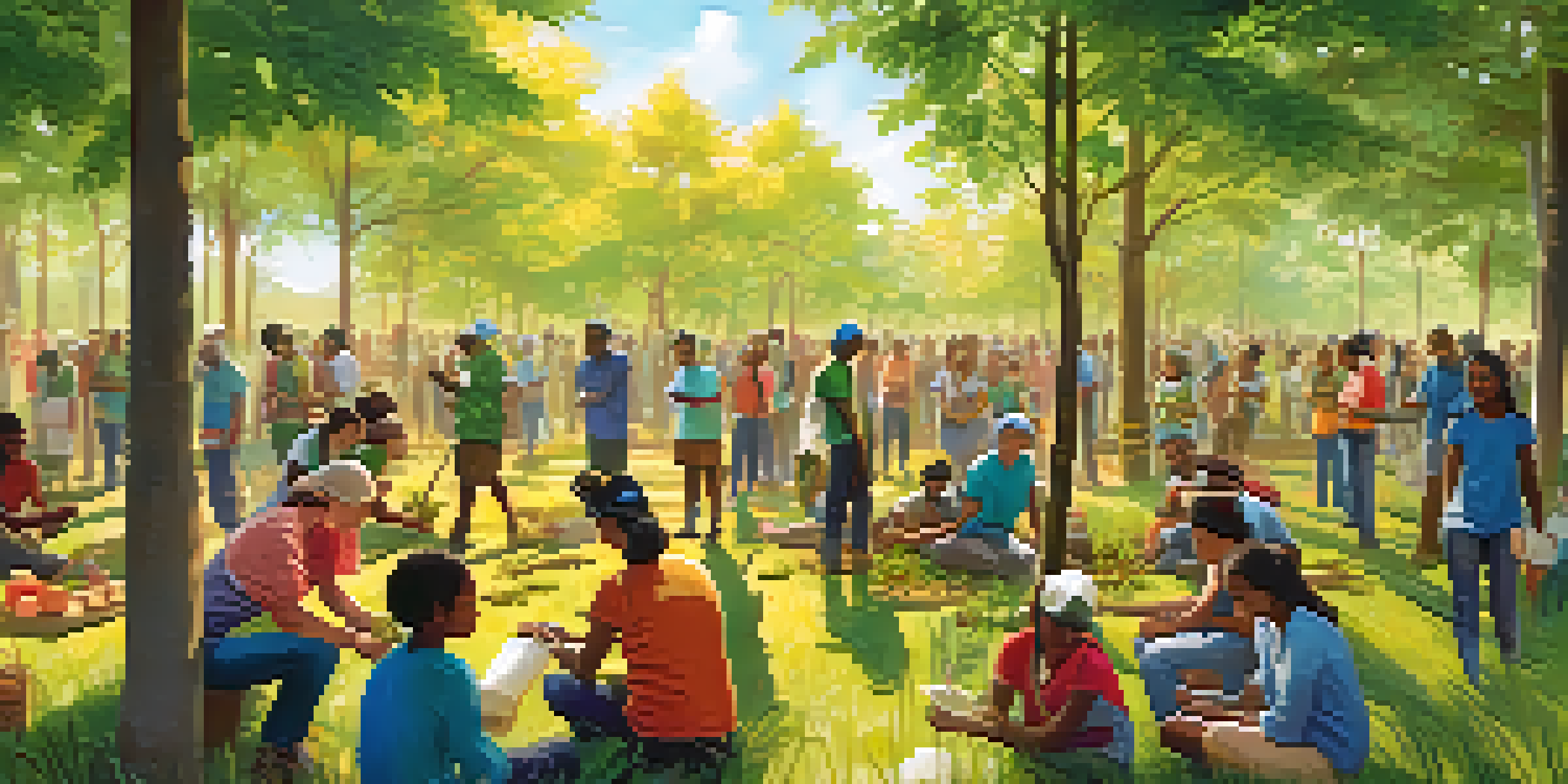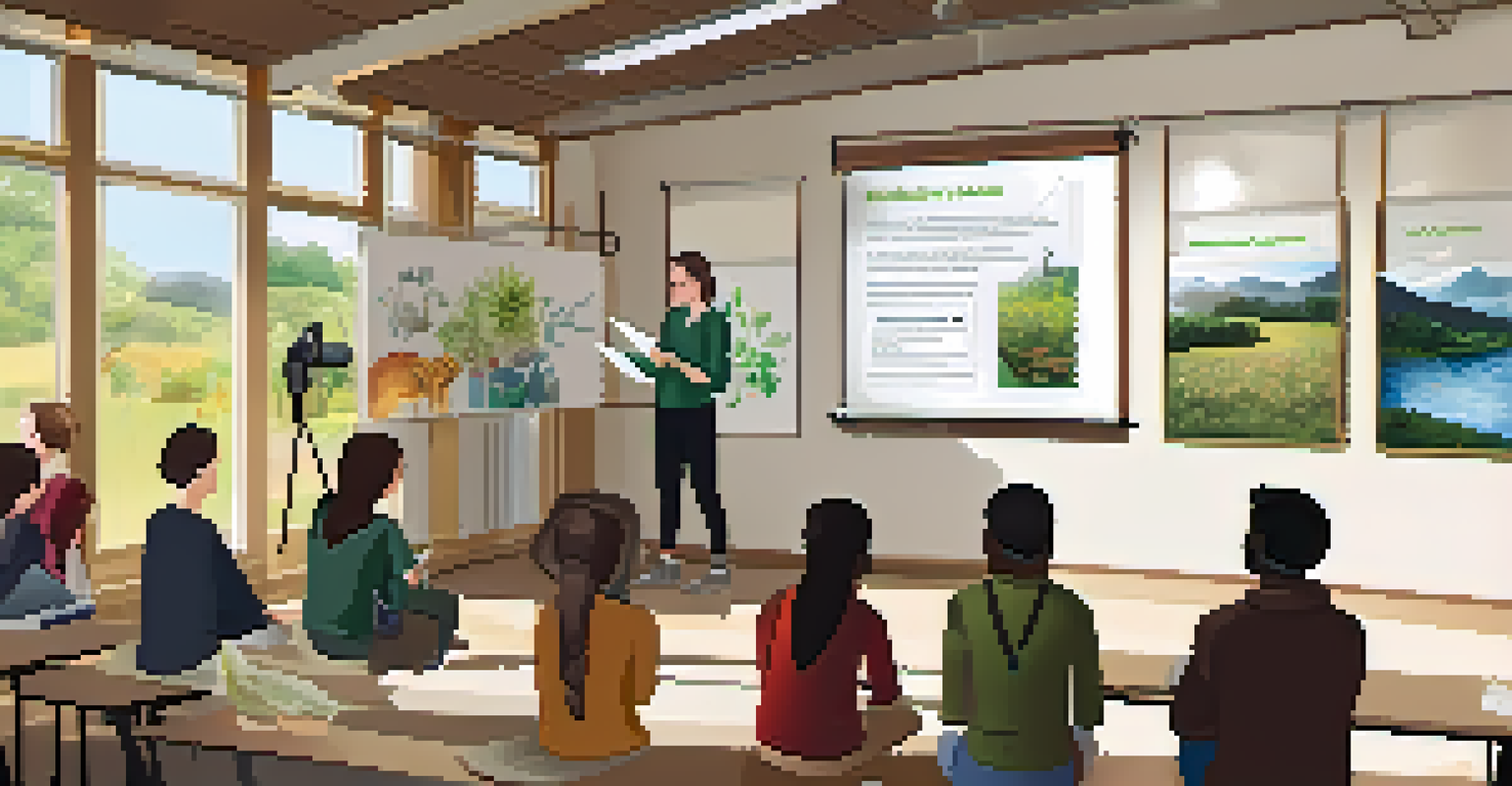The Role of Community in Conservation Efforts

Understanding the Importance of Community in Conservation
Communities play a vital role in conservation efforts by connecting local knowledge with environmental practices. When residents understand the ecosystems around them, they can advocate for sustainable practices that protect their natural resources. This relationship often leads to a stronger commitment to conservation, as people see the direct impact on their lives and surroundings.
The greatest threat to our planet is the belief that someone else will save it.
For instance, local fishermen may notice changes in fish populations and advocate for sustainable fishing methods. Their firsthand observations can drive significant policy changes, highlighting how crucial community input is in addressing environmental concerns. Ultimately, it's this shared knowledge that lays the foundation for effective conservation strategies.
Moreover, when communities are involved in conservation, it fosters a sense of ownership and responsibility. People are more likely to care for the environment when they feel they have a stake in its future. This bond between the community and its natural resources is what drives conservation efforts forward.
Community-Led Initiatives: A Path to Successful Conservation
Community-led initiatives have proven to be incredibly effective in conservation efforts. These projects often arise from the unique needs and goals of the community, ensuring that conservation strategies are tailored and relevant. This localized approach often results in more sustainable practices that resonate with residents.

For example, community-based reforestation projects allow locals to plant trees in areas that have been deforested. By engaging community members in every step of the process, from planning to planting, these initiatives ensure that the reforestation efforts are well-maintained and respected. This level of involvement fosters a deeper connection to the land.
Community Engagement Drives Conservation
Communities play a crucial role in conservation by leveraging local knowledge and fostering a sense of ownership over their natural resources.
Additionally, when communities take charge of conservation initiatives, it can lead to the development of innovative solutions. These grassroots efforts often leverage local resources and knowledge, creating unique strategies that larger organizations might overlook. It's this creativity that can lead to groundbreaking conservation successes.
Education and Awareness: Empowering Communities for Change
Education plays a crucial role in empowering communities to engage in conservation efforts. By providing resources and training, organizations can help locals understand the environmental issues affecting their area. This knowledge equips them to make informed decisions about their natural resources and the actions they can take.
We won't have a society if we destroy the environment.
Workshops, seminars, and hands-on training can inspire community members to take action. For instance, teaching locals about the benefits of biodiversity can lead to grassroots campaigns aimed at protecting endangered species within their region. When communities are educated, they can advocate for their needs effectively.
Moreover, increased awareness can spark a cultural shift towards conservation. As more community members become informed and engaged, they can influence their peers, creating a ripple effect. This collective effort strengthens the community's impact on conservation and can lead to lasting change.
Building Partnerships: Strengthening Conservation Through Collaboration
Building partnerships between communities and conservation organizations can amplify efforts and resources. When local communities collaborate with NGOs, they can pool knowledge, funding, and manpower to tackle environmental challenges more effectively. This synergy can lead to more robust and impactful conservation projects.
For example, a partnership between a local community and a wildlife organization can provide the community with training in sustainable practices while also offering the organization valuable insights into local wildlife patterns. These collaborative relationships can create a win-win situation, enhancing conservation outcomes while empowering locals.
Education Empowers Local Action
Education and awareness initiatives equip community members with the knowledge to advocate for sustainable practices and engage in conservation efforts.
Furthermore, these partnerships often foster a sense of unity and shared purpose. When communities work together with external organizations, it not only strengthens their resolve but also builds trust in the conservation process. This trust is essential for long-term success and sustainability.
Cultural Heritage and Conservation: A Symbiotic Relationship
Cultural heritage plays an integral role in conservation efforts, as many traditional practices are inherently sustainable. Communities often have generations of knowledge regarding the management of local resources, and this wisdom can be invaluable for modern conservation strategies. By integrating cultural practices, conservation efforts can become more effective and respectful.
For instance, indigenous communities often utilize land management techniques that have proven sustainable over centuries. Recognizing and incorporating these practices into contemporary conservation efforts can lead to more effective outcomes. This respect for cultural heritage not only benefits the environment but also honors the community’s identity.
Moreover, celebrating cultural heritage can enhance community involvement in conservation. When people see their traditions reflected in conservation efforts, they are more likely to participate and support these initiatives. This connection not only helps preserve the environment but also strengthens community bonds.
Challenges Facing Community Involvement in Conservation
Despite the many benefits of community involvement in conservation, challenges can arise. One significant hurdle is the lack of resources and funding available to local organizations. Without financial support, communities may struggle to implement or sustain their conservation initiatives, hampering their efforts.
Additionally, there may be conflicts of interest among community members regarding land use and conservation goals. Balancing economic needs with environmental protection can create tension and hinder collaborative efforts. Open communication and negotiation are essential to navigate these complexities and reach a consensus.
Partnerships Enhance Conservation Impact
Collaborative partnerships between communities and conservation organizations amplify resources and strengthen the overall effectiveness of conservation projects.
Lastly, external pressures such as climate change and industrialization can outpace community efforts. While local initiatives are vital, they often need the backing of larger policies and frameworks to create significant change. Building strong networks and advocacy can help communities overcome these challenges.
The Future of Conservation: Communities Leading the Way
As we look to the future, it's clear that the role of communities in conservation will only grow more significant. Empowered communities are increasingly seen as key players in addressing environmental challenges. Their local knowledge, cultural practices, and passion for their land can drive meaningful change.
Moreover, advancements in technology are enabling communities to monitor and manage their natural resources more effectively. From using drones for wildlife tracking to mobile apps for reporting environmental issues, these tools can enhance community engagement and conservation efforts. Technology is bridging gaps and creating new opportunities.

Ultimately, communities have the potential to lead the way in conservation. By harnessing their unique strengths and collaborating with stakeholders, they can create sustainable solutions that benefit both the environment and their way of life. The future of conservation lies in the hands of those who know their land best.